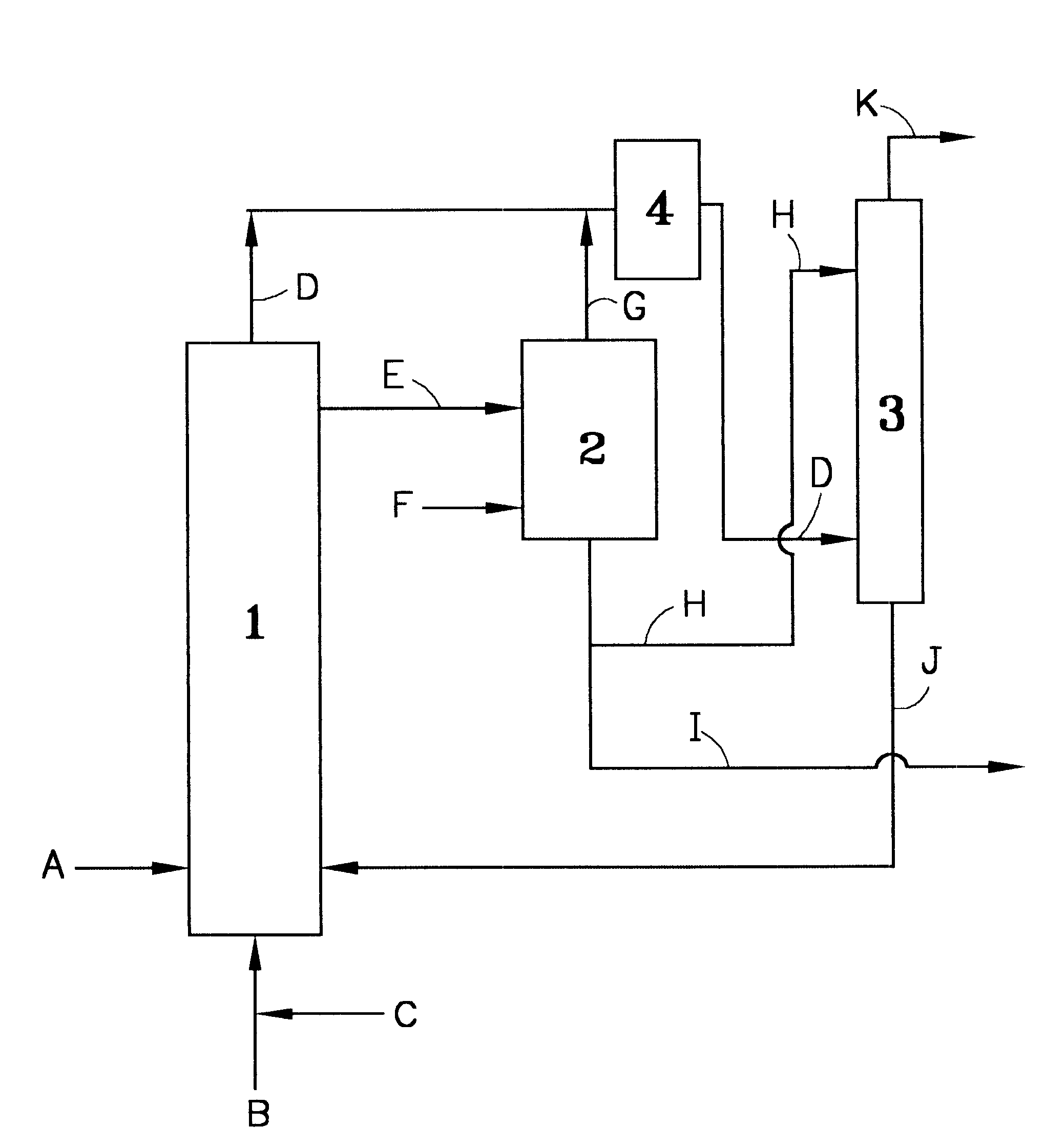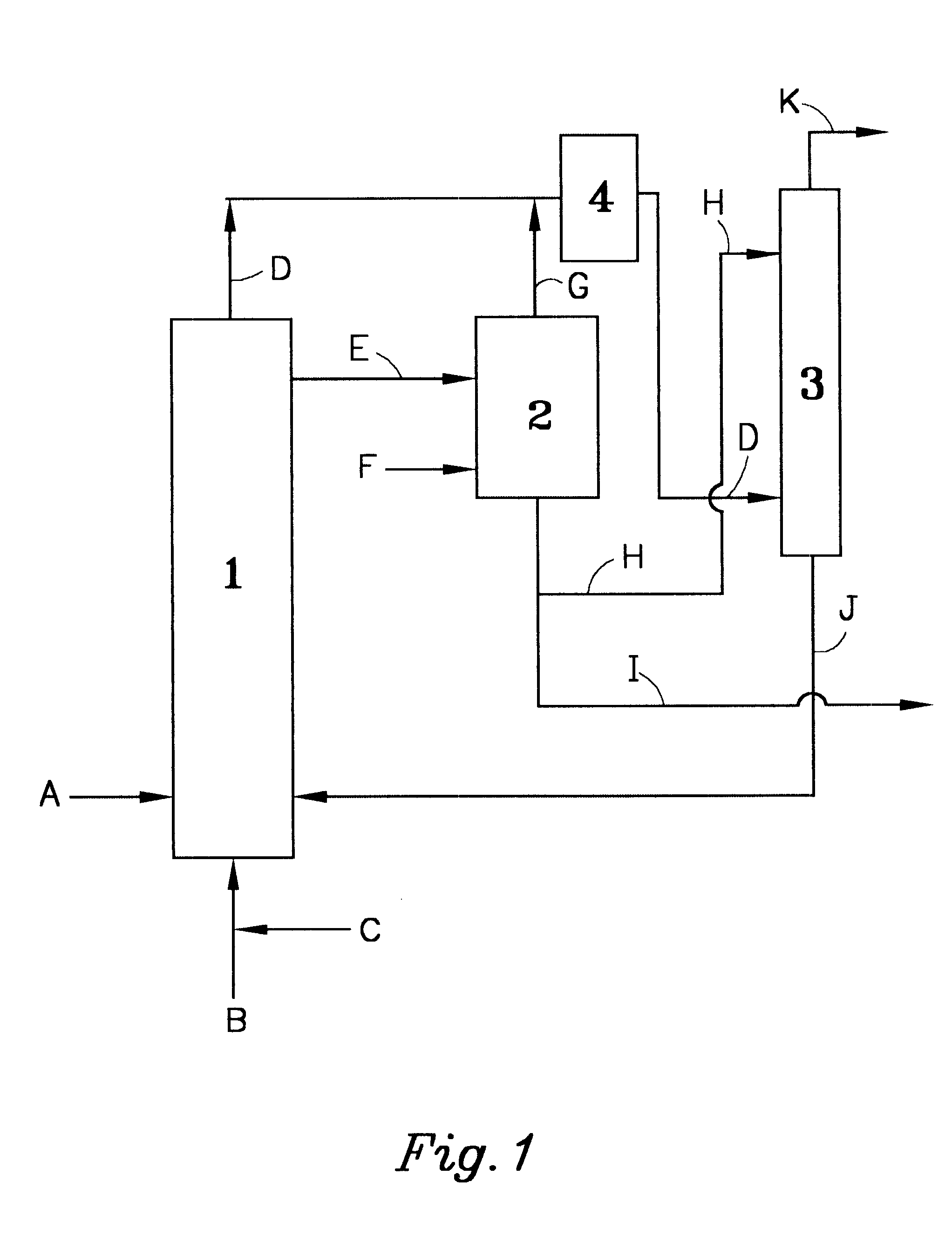Process for producing dimethyl sulfoxide
a technology of dimethyl sulfoxide and dimethyl sulfoxide, which is applied in the direction of physical/chemical process catalysts, organic chemistry, chemistry apparatus and processes, etc., can solve the undesirable dispersal of used catalyst nox, high cost and effective utilization of resources, and high purchase price of highly pure oxygen gas with an oxygen concentration of 99% or more used here, so as to improve the recovery rate and/or absorption rate of nox, the effect of efficient dms
- Summary
- Abstract
- Description
- Claims
- Application Information
AI Technical Summary
Benefits of technology
Problems solved by technology
Method used
Image
Examples
example 1
The drawing illustrates the outline of the recovery equipment and process used for recovering NOx of the present invention.
In the drawing, DMS was supplied from a pipe 1 at a rate of 100 g per hour (hereinafter expressed as (g / h)), catalyst NOx, from a pipe 2 at a rate of 0.6 (g / h), and oxygen, from a pipe 3 at a rate of 30.5 (g / h), respectively, to an oxidation reactor 4 (4 cm dia. .times.50 cm), and oxidation reaction was effected at a reactor temperature of 30.degree. C. The reaction off gas containing oxygen and NOx was supplied through a pipe 5 to a NO oxidizing reactor 6 and a NOx absorbing column 7 (1 cm dia..times.50 cm) for recovery of NOx. To a degassing tank 8 (2 cm dia..times.20 cm), the reaction product solution produced in the oxidation reactor 4 was supplied from a pipe 9, and furthermore nitrogen gas was supplied from a pipe 10 at a rate of 10 (g / h), to remove NOx in the reaction product solution. The temperature of the degassing tank 8 was 50.degree. C. The NOx remo...
example 2
In the drawing, DMS was supplied from the pipe 1 at a rate of 100 (g / h), catalyst NOx, from the pipe 2 at a rate of 6.2 (g / h) and a gas with an oxygen concentration of 90% obtained by PSA, from the pipe 3 at a rate of 34.0 (g / h), respectively to the oxidation reactor 4, and oxidation reaction was effected at a reactor temperature of 30.degree. C. The reaction product solution mainly composed of DMSO produced in the oxidation reactor 1 was supplied from the pipe 9 to the subsequent step. The amount of the reaction product solution supplied in this case was 124.8 (g / h) . Furthermore, the reaction off gas containing oxygen and NOx was supplied from the pipe 5 to the subsequent step. The amounts of oxygen and NOx in the reaction off gas in this case were 12.2 (g / h) and 2.4 (g / h) respectively. The conversion into DMSO in this DMS liquid phase continuous oxidation was more than 99%.
example 3
In the drawing, DMS was supplied from the pipe 1 at a rate of 100 (g / h), catalyst NOx, from the pipe 2 at a rate of 0.6 (g / h) and a gas with an oxygen concentration of 90% obtained by PSA, from the pipe 3 at a rate of 34.0 (g / h), respectively to the oxidation reactor 4, and oxidation reaction was effected at a reactor temperature of 30.degree. C. The reaction off gas containing oxygen and NOx was supplied through the pipe 5 to the NO oxidizing reactor 6 and the NOx absorbing column 7 for recovery of NOx. The reaction product solution produced in the oxidation reactor 4 was supplied from the pipe 9 to the degassing tank 8 at a rate of 124.5 (g / h), and furthermore nitrogen gas was supplied to the degassing tank 2 from the pipe F at a rate of 10 (g / h) , to remove NOx in the reaction product solution. The temperature of the degassing tank 2 in this case was 50.degree. C. The removed NOx was supplied to the NO oxidizing reactor 6 and the NOx absorbing column 7 through the pipes 11 and 5....
PUM
| Property | Measurement | Unit |
|---|---|---|
| Angle | aaaaa | aaaaa |
| Angle | aaaaa | aaaaa |
| Angle | aaaaa | aaaaa |
Abstract
Description
Claims
Application Information
 Login to View More
Login to View More - R&D
- Intellectual Property
- Life Sciences
- Materials
- Tech Scout
- Unparalleled Data Quality
- Higher Quality Content
- 60% Fewer Hallucinations
Browse by: Latest US Patents, China's latest patents, Technical Efficacy Thesaurus, Application Domain, Technology Topic, Popular Technical Reports.
© 2025 PatSnap. All rights reserved.Legal|Privacy policy|Modern Slavery Act Transparency Statement|Sitemap|About US| Contact US: help@patsnap.com


